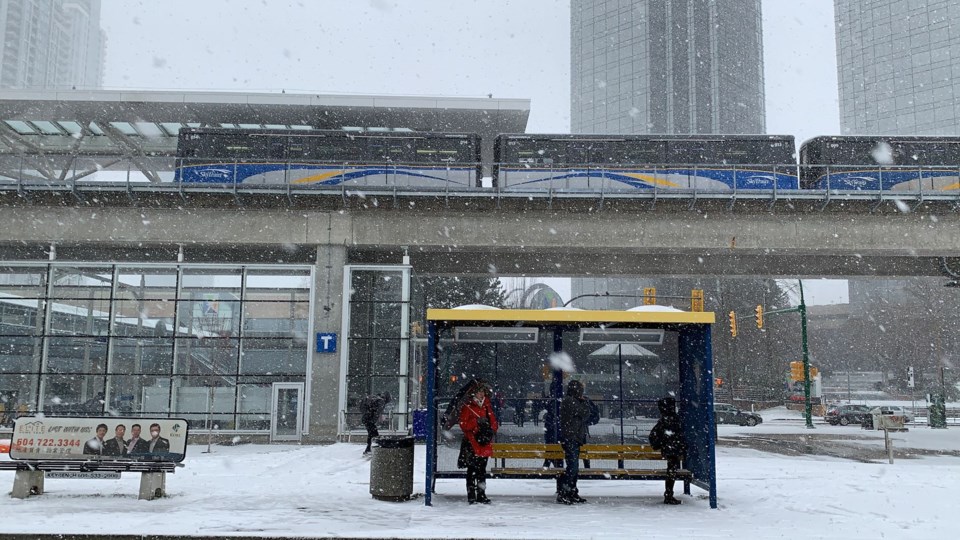Vancouver is bracing for an onslaught of winter weather following an Environment Canada special weather statement calling for snowfall and freezing temperatures.
The City is anticipating the incoming cold weather will have a significant impact on the unhoused and Vancouver's road conditions.
To prepare, a number of warming spaces and emergency shelters will be opening tonight (Nov. 28) in addition to the Temporary Winter Shelters, which are open every night between November and March.
The Warming Centres, which open when the temperature feels like -5 C or below, will be set up at Powell Street Getaway (9 p.m. – 7:30 a.m.), Odd Fellows Hall (starting Tuesday 9:30 p.m. – 8:30 a.m.), and Marpole Neighbourhood House (10 p.m. – 8:30 a.m.). There won't be beds or mats but hot drinks and snacks are available.
Extreme Weather Response Shelters provide mats to sleep on and will be open at Directions Youth Services Centre (10 p.m. – 7 a.m.), Cascades Church (9:30 p.m. – 9 a.m.), Bud Osborn EWR (7 p.m. – 7 a.m.), The Salvation Army Belkin House (9 p.m. – 7 a.m.), and the Langara YMCA (9:30 p.m. – 7 a.m.). Depending on the shelter, guests can bring pets, bikes and carts with them.
Vancouver is expected to receive its first heavy snowfall Tuesday and the city is prioritizing snow and ice treatment for:
- Major roads and bus routes.
- Bridges and bridge sidewalks.
- Main streets adjacent to major hospitals.
- The four major pedestrian pathways - Arbutus Greenway, Central Valley Greenway, False Creek Seawall, and Coal Harbour Seawall.
- The 16 most-used bike routes.
Residential side streets are not included in the city's treatment plans unless they happen to correspond with a priority hill or provide access to hospitals and schools. If your car is parked on a major road it's a good idea to move it to a side street to make way for the plows.
The city asks that on snow days the public only takes essential trips and helps to keep roads and walkways clear. Bylaw states that Vancouver property owners and tenants are responsible for clearing snow and ice from the full width of sidewalks that surround their property by 10 a.m. on the morning following a snowfall and failure to do so may result in a fine.
There is a city-endorsed Snow Angel program that matches volunteers with homes of people with mobility issues who aren't able to shovel their walks.
The city also warns of the overuse of salt which can cause harm to pets and other wildlife, including plants and pollute water. They ask that the public uses it sparingly, only after the snow is removed, and to clear up any excess.
TransLink has also put together a winter travel guide and is calling in extra staff to coordinate service.
Articulated buses are being replaced with 40’ conventional buses, when necessary, as they are more agile in steep, slippery areas.
The Millennium Line trains are switching to four-car configurations to increase capacity and SkyTrain attendants will be on-scene to monitor guideways. A special overnight SkyTrain is also being introduced to spray de-icer on the tracks to keep trains moving.
If conditions worsen, TransLink reports it will introduce the following tactics:
- Install brass “cutters” on some trolley buses to cut through ice on trolley wires.
- Install tire socks on buses on specific Vancouver routes, where hills and traction are an issue.
- Implement a UBC Snow Shuttle (UBC from Alma to UBC via Blanca Loop).
- Position SkyTrain attendants at the front of each Expo and Millennium Line train to improve the reliability of the system by limiting emergency braking triggered by heavy snowfall.
- Run trains through the night if snow is especially heavy to keep tracks clear.
- Equip HandyDART service with two staff members per vehicle to ensure customers get safely to their door and assist in digging out the bus if required.
- Activate further staff increases to assist customers across the system.
Transit riders are encouraged to build in extra travel time and plan their commutes ahead of time. They can sign up for Transit alerts, use Trip Planner, or follow TransLink on Twitter.



